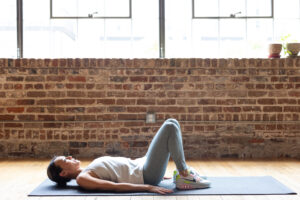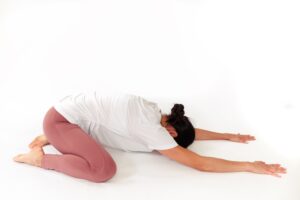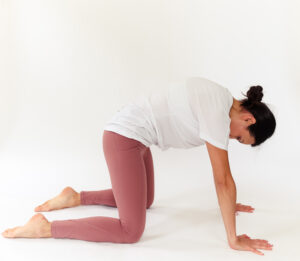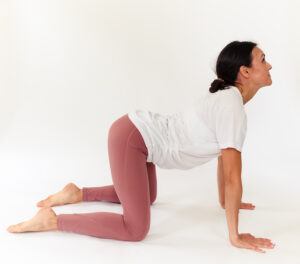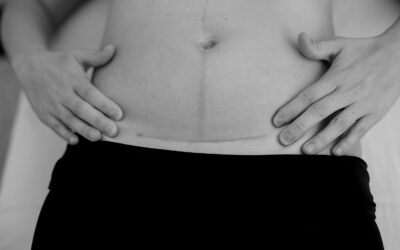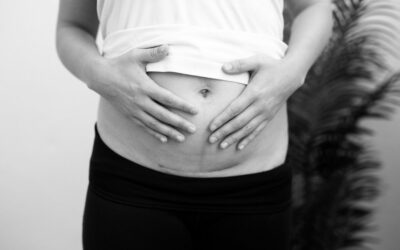During my pregnancy, I knew I wanted to breastfeed my son. I read the books, bought the supplies, had the breastfeeding pillows, salves, and shirts, and had the pump, rocking chair, and ice packs. I was ready for sore nipples and sleepless nights. However, I was not prepared for the back pain. You may have residual back pain from pregnancy and delivery, or you may experience lower back pain from spending so much time sitting while nursing and snuggling your new little squish. You may even have aches and pains in your upper back and shoulders.
Read on for some tips, positions, and exercises to keep your breastfeeding back pain at bay or, even better, prevent it from happening in the first place.
Breastfeeding shoulder pain
Breastfeeding shoulder pain is common and also known as nursing mother’s neck. Neck pain is common as well. Check your posture while feeding if you experience pain, numbness, tingling, etc. The repetitiveness of breastfeeding for hours on end is the culprit.
Breastfeeding upper back pain
Upper back pain is common and can present with a sore neck, sore spinal cord, and sore upper back after a feeding session. Remember not to look down at the baby or hunch over too much. Sit in the correct position to avoid breastfeeding upper back pain (tips on those below!).
Breastfeeding lower back pain
Lower back pain is common after birth and while breastfeeding. Whether you gave birth vaginally or via cesarean, your abdominal muscles have been hard at work, and their instability can lead to back pain and poor posture.
Tips to avoid breastfeeding back pain
For optimal back support, bring the baby to your breast
Don’t bring your boob to the baby when feeding your baby. Avoid slouching or leaning forward to nurse as this can cause back pain when breastfeeding. Bring your baby up to you for a proper starting position.
If your neck aches, shoulders are slumped, and abs feel weak, try using pillows for support under your baby, your knees, and behind your back to decrease pain, improve posture, and help with better latching.
Placing more pillows under your knees or a stool under your feet can also help with back pain.
Nursing pillows work well, but if you have a long torso, you might need more than one to ensure your baby is right at your breast. I love the My Breast Friend pillow for the early newborn days, and the Boppy Pillow as the baby gets a bit bigger. Plus, you can leave one pillow in your bedroom or nursery and one in the main area – you can never have too many nursing pillows!
Change positions regularly
After your baby is done nursing (until 10 minutes from now), try to move around for a few minutes. Going for a walk outside always helped my back pain and, often, my mood! Plus, most babies love to go for walks, too!
Stay hydrated
It’s essential to stay hydrated while breastfeeding, and you’ll likely need more water than normal. So keep a water jug or cup nearby your feeding station. If you have a partner, make it their duty to ensure it stays filled up at home. Some apps will even periodically remind you to take a sip.
Choose the right chair
Those deep, comfy gliders may look like the perfect place to spend hours nursing, but an upright, firm chair is much better for the back. Unfortunately, I learned that a little too late, but I could compensate by ensuring I had a lumbar support pillow behind my back and a little stool to support my feet and not dangling or barely touching the ground.
Back support when breastfeeding is crucial, so if able, keep both feet firmly on the floor. Your back should also be flush with the back of the chair. If it’s not, try adding a pillow for extra back support. If the pain is too much and you’re thinking of taking medicine, remember to check with your doctor to ensure it’s safe for you and your baby.
Your back pain might be worse at night when breastfeeding
Exercises and stretches will be helpful as well as massage. You can do the stretches before, during, and after breastfeeding. Our top four stretches to relieve breastfeeding back pain are below. If you can, sleep when the baby sleeps (easier said than done, we know) and take breaks in between when switching sides, as mentioned above. Heat packs or hot compresses may temporarily relieve pain as well.
The best breastfeeding positions to reduce back pain
- Sitting – Sit with your back supported and your feet on the ground or a stool. You should be sitting upright. Make sure that you aren’t leaning forward to nurse. Bring baby up to you with the support of pillows. If you are using your left breast to feed, your left hand should be holding your breast, cupped. Switch for the right.
- Side-lying – Lay on your side facing your baby with your bellies close to each other and the baby’s head at the level of your breast. You can lay your head on a pillow with your bottom arm resting on the bed, extended above the baby’s head. Make sure that no pillows or blankets are near your baby.
- Upright baby – Once your baby sits up, you can use that to your advantage! I frequently nursed my son with him sitting on my lap facing me. I could even recline a little, which took even more stress off my back.
- Standing with baby in a carrier – Nursing while baby-wearing is not only for times when you are on the go! Nursing with your baby in a sling, wrap, or soft structured carrier while standing is a great way to give your back a great break from sitting. Check out Babywearing International for local meet-ups to try out different carriers or get help with one you already own.
Exercises to help relieve back pain from breastfeeding
Below are my top four exercises to help relieve breastfeeding back pain. Always remember to do deep breaths while performing them.
Shoulder rotations
- Start lying on your side and open your arms, and rotate your chest to the opposite side
- Add a resistance band to start strengthening your back and shoulders to improve your posture
- Progress to standing shoulder rotations to open up your chest a shoulder after being hunched forward
Shoulder blade squeezes
Sit in your chair and gently bring your shoulder blades together while keeping your shoulders down. Hold for 5 seconds and relax. Repeat 10-15 times, 2-3 times per day.
Transverse abdominus contractions
Lie down on your back with your knees bent. Gently pull in your lower belly like you are buttoning a pair of pants that are a little bit too tight. Hold for 5 seconds and relax completely. Repeat 10-20 times per day.
Child’s pose and cat cow pose
Start kneeling with your knees at least hip-width apart and your big toes touching. Bring your butt down onto your heels as your stretch the rest of your body down and forward. Bring your arms forward as you rest your stomach on top of your thighs and your forehead on the floor or mat. Cat cow pose is another good movement to try
More resources on breastfeeding
Are you searching for more resources on breastfeeding? Check out these four books we love. These books can be a resource as you prepare for and troubleshoot during your breastfeeding journey. Breastfeeding is a relationship. It has to work for both you and your child. And most importantly, your worth is not measured in ounces!
______________________________________________________________________________________________________
If you want to know more about taking great care of your pelvic floor, get my FREE GUIDE with 6+ Simple Tips to Prevent or Overcome Pelvic Floor Problems.
______________________________________________________________________________________________________
P.S. Did you know breastfeeding impacts your pelvic floor, too?
Some links may be affiliate links. The products we recommend are products we use or recommend to clients.


